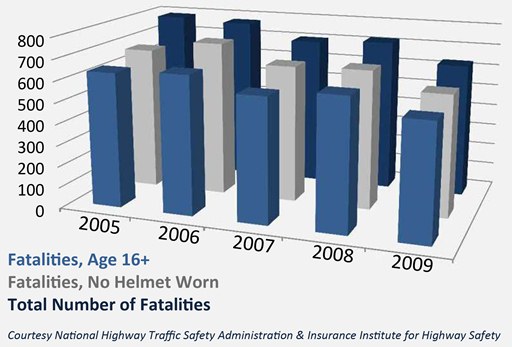Bicycle Safety – California Bicycle Law & Common Sense
 Bike Accident Attorney
Bike Accident Attorney
by Andrew L. Shapiro
(818) 907-3230
According to the National Highway Traffic Safety Administration, 630 people died in 2009 because of non-motorized cycling accidents, and 51,000 were injured. Those are national figures. But the California Department of Motor Vehicles cites about 99 bicycle fatalities each year in our own state. The numbers of California bicycle deaths make up a large percentage of the national figure.
Many times, bicycle deaths occur simply because the bicyclist wasn’t seen by a driver. But every now and then you hear of a bicyclist who was seriously injured or died because of road hazards.
So let’s take a moment to review the rules of the road, so you can protect yourself and stay safe when two-wheeling.
Deaths for bicyclists over age 16 increased by 69 percent since 1975. The average age of the people killed while cycling from 2005 to 2009 is 40.
California Bicycle Law – Reviewing the Basics

First, you should know that a bicycle is considered a vehicle in California. That means you must:
- Obey all traffic signals and signs.
- Ride in the same direction as other vehicular traffic.
- Ride on the road, close to the curb, and not on the sidewalk.
- Signal when turning.
- Wear a helmet if you are under 18.
There are other California bicycle laws to follow, but these five are the most basic, and the ones we see bicyclists violating the most often. You can check the more complete list of bicycle safety rules on the California DMV website page Sharing the Road With Other Vehicles.
Bicycle Safety – Paying Close Attention
How’s your biking environment? Assuming you’re following California bicycle law, are your favorite routes kept safe for your ride?
There are many factors that could affect a bicyclist’s safety, and we have handled many bicycle accident cases where we found construction company or governmental negligence causing serious injuries and even fatalities.
So when it comes to bicycle safety, watch out for these hazards:
Drainage or Sewer Grates: If the slats run in the direction of traffic, you might be thrown from your bike if your wheels get caught in the grate. We represented a client who was seriously injured because of an ill-fitting grate in Malibu, recently. One of his wheels got stuck in the space between the grate and the pavement.
Potholes: Weather and heavy traffic create them, and hopefully the city or county will repair them. And hopefully they’ll be repaired correctly. Watch out for potholes and buckles in the road that may throw you off balance. Watch out especially if the potholes are water-filled, since you may not be able to tell how deep the hole is.
Railroad Tracks: Just like the sewer grates mentioned above, if the rails run with traffic, you might get a tire caught in the groove between the rail and the pavement.
Road Shoulders: Since riding your bike on a sidewalk is illegal in many California municipalities (not illegal in the City of Los Angeles unless you’re riding in a dangerous manner), you may want to use the road. Shoulders can be hazardous to bicyclists though, particularly if they’re too narrow and you’re forced into the road, or if rumble strips force you into the road. Use a specified bike lane whenever you can. But if you are forced to move off the shoulder and into the road be sure to look for oncoming traffic, and to use hand signals to alert drivers to what you are doing.
Slick Spots: Look out for wet pavement and leaves, oil spills and painted pavements.

These are just some of the hazards you’ll need to keep watch for when riding a bicycle. In addition, don’t forget the dangers of other drivers: those that don’t signal before turning or switching lanes, those that drive distracted, and those that just don’t see you sharing the road.
Whether you’re driving a two, four, six or 18-wheeler, keep safe, drive defensively, and always look twice before changing lanes or turning.
Andrew L. Shapiro is an Accident Lawyer and Chair of our Personal Injury Practice Group. Contact him via e-mail: ashapiro@lewitthackman.com.
